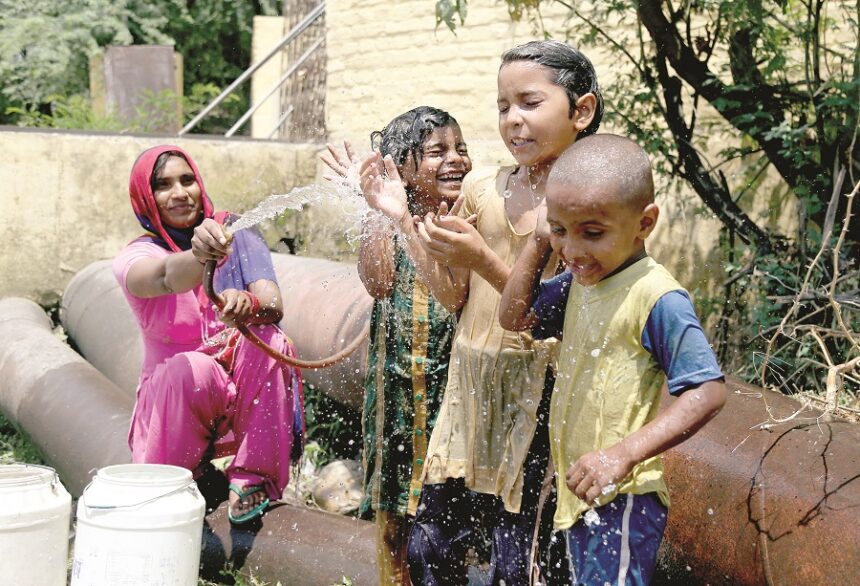Kokernag, Bhaderwah witnesses second highest temperature in 2 decades
Jammu reached a maximum temperature of 42.5°C
JKDMA issues warning of extreme fire risk in forests
Srinagar, May 26: Kashmir is witnessing hot and dry weather conditions for the past one week, Qazigund town in south Kashmir, recorded the second highest temperature at 33.5°C on Sunday. This is the second-highest temperature recorded in May in the past 43 years, officials said.
Director Meteorological Department Centre Kashmir, Dr Mukhtar Ahmad told Rising Kashmir that Qazigund recorded the second highest in the past 43 years and sizzled at 33.5°C. He said the highest was 33.6°C, recorded on May 31, 1981.
Dr Mukhtar further said that the second highest maximum temperature of 31.5°C was recorded also in Kokernag, the highest being 32.6°C on May 15, 2001.
Meanwhile Bhaderwah also experienced its second highest maximum temperature in 23 years at 34.8°C, with the highest being 37.6°C on May 30, 2000. In Jammu, the maximum temperature reached 42.5°C and there is no respite in heatwave in the region.
Dr Mukhtar said that the heat wave will continue over plains of Jammu & Kashmir divisions during the next 3 days. We urged people to avoid heat exposure & drink a lot of fluid and water, especially vulnerable people.
Briefing about the weather forecast, he said that from 27-28th May, weather will remain generally dry weather with possibility of thundershower activity at isolated places cannot be ruled out.
“Similarly, from 29-30th, weather will remain partly to generally cloudy with light rain along with thunder at isolated places towards A/N. Overall, no significant weather activity till 31st May, ” he said.
As per MeT data, Srinagar recorded 32.7°C as the maximum temperature and 15.7°C as minimum temperature. Ski resort Gulmarg in north Kashmir recorded a high of 22.6 degrees Celsius and 11.0 as minimum temperatures.
Health resort Pahalgam in south Kashmir recorded 28.1°C as maximum temperature and 8.3°C as the minimum temperature. Kokernag recorded 31.5°C as the maximum temperature, 13.2°C as minimum temperature.
Kupwara in north Kashmir recorded maximum temperatures of 30.5°C. Banihal recorded 32.6°C as the maximum temperature.
Meanwhile Jammu is witnessing hot and humid weather conditions and recorded at 42.5°C as maximum temperature and 24.5 as minimum temperatures. Katra recorded 38.2°C and 23.2°C as the minimum temperature.
Last week, Srinagar recorded a high of 31.6°C, marking it as the hottest day of the season and the third warmest May ‘day’ in the past decade for the summer capital.
The MeT spokesman said during the past 10 years from 2014 to 2024, the maximum temperatures in May have ranged from 28.5°C to 31.9°C. Minimum temperatures have varied between 5.0°C and 9.8°C.
As temperatures rise across Kashmir, authorities are on high alert for forest fires. The Jammu and Kashmir Disaster Management Authority (JKDMA) has issued a warning of extreme fire risk for next week. Residents are urged to report fires immediately by dialing 112.
A JKMA spokesman said that the ongoing heat wave, with rising temperatures, low humidity, and dry conditions, has significantly increased the wildfire risk. There is a need for the importance of vigilance and early reporting to prevent fires from spreading and causing extensive damage to the environment, wildlife, and property, he said.
“Authorities are coordinating with the Forest Department and emergency services to ensure a prompt response to any incidents. Public cooperation is essential; people should report any signs of fire or smoke immediately,” the spokesman said.
Kashmir is facing a severe environmental crisis with forest fires threatening the region’s greenery. Dry weather and high temperatures have already destroyed acres of forest land, impacting biodiversity and air quality.
Firefighting teams, including aerial resources, are working to control the fires, but the rugged terrain makes their efforts challenging.
The fires are particularly severe in the forests of Baramulla, Kupwara, and Bandipora districts, where dense vegetation has become a tinderbox. Wildlife habitats are also at risk, with animals fleeing the flames.








